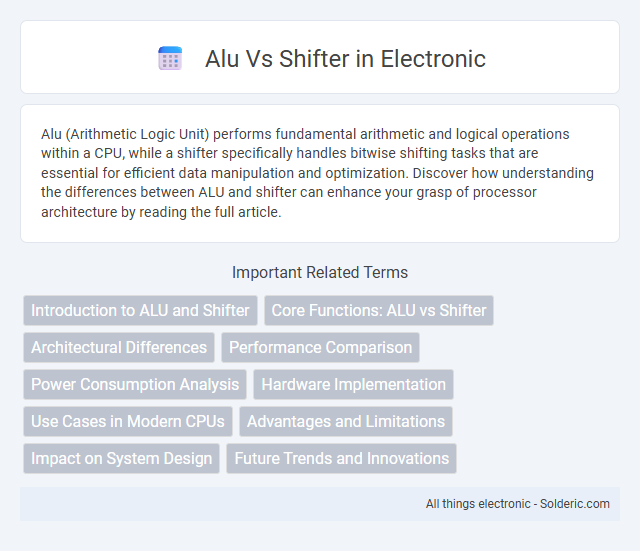Alu (Arithmetic Logic Unit) performs fundamental arithmetic and logical operations within a CPU, while a shifter specifically handles bitwise shifting tasks that are essential for efficient data manipulation and optimization. Discover how understanding the differences between ALU and shifter can enhance your grasp of processor architecture by reading the full article.
Comparison Table
| Feature | ALU (Arithmetic Logic Unit) | Shifter |
|---|---|---|
| Function | Performs arithmetic (add, subtract) and logic (AND, OR, XOR) operations | Performs bit-shift operations (logical, arithmetic, rotate) |
| Operation Complexity | High - multiple arithmetic and logical functions | Low - specialized in shifting bits |
| Input | Two binary operands | One binary operand and shift count |
| Output | Result of arithmetic or logic operation | Shifted binary value |
| Typical Usage | CPU core for calculations and decision making | Bitwise manipulation, multiplication/division by powers of two |
| Example | Addition, AND operation | Left shift, right rotate |
Introduction to ALU and Shifter
An Arithmetic Logic Unit (ALU) performs fundamental arithmetic operations such as addition and subtraction, along with logical operations like AND, OR, and XOR, serving as a critical component in digital processors. A shifter specifically handles bitwise shifting operations, including logical, arithmetic, and rotate shifts, enabling efficient data manipulation and alignment. While ALUs execute a wide range of arithmetic and logic tasks, shifters focus exclusively on shifting bits within binary data.
Core Functions: ALU vs Shifter
The Arithmetic Logic Unit (ALU) performs core functions including arithmetic operations like addition, subtraction, multiplication, and division, as well as logical operations such as AND, OR, and XOR. The shifter primarily handles bitwise shift operations, moving data left or right to facilitate tasks like multiplication or division by powers of two and bit manipulation. Your processor relies on the ALU for complex computations while the shifter optimizes data alignment and bit-level transformations.
Architectural Differences
The Arithmetic Logic Unit (ALU) performs a wide range of operations including addition, subtraction, bitwise operations, and comparison, while the shifter specifically handles bit shift operations such as logical, arithmetic, and circular shifts. Architecturally, the ALU consists of multiple subunits for arithmetic and logic processing with multiplexers to select outputs, whereas the shifter uses barrel shifters or multiplexed routing to move bits efficiently within a word. The ALU's complexity supports varied computational tasks, whereas the shifter is optimized for speed and simplicity in manipulating bit positions.
Performance Comparison
ALUs (Arithmetic Logic Units) excel in executing a broad range of arithmetic and logical operations with moderate latency, while shifters specialize in bit-shifting tasks, offering faster execution times for shift operations due to their simplified circuitry. The performance gap between ALUs and shifters becomes apparent in pipeline design, where shifters enhance throughput by reducing critical path delays during shift-intensive computations. Optimizing system performance in digital design often involves integrating dedicated shifters alongside ALUs to balance operational versatility and speed efficiency.
Power Consumption Analysis
The power consumption of an Arithmetic Logic Unit (ALU) is generally higher than that of a shifter due to the ALU's complex operations, including arithmetic calculations and logic functions, which require multiple transistor switching activities. Shifters primarily perform bitwise shift operations, resulting in simpler circuitry and lower dynamic power usage. Optimizing ALU design for power efficiency involves techniques like operand gating and voltage scaling, whereas shifter power consumption improvements often focus on circuit simplification and reduced switching capacitance.
Hardware Implementation
Hardware implementation of ALUs (Arithmetic Logic Units) involves complex circuitry capable of performing multiple arithmetic and logical operations using combinational logic and multiplexers. Shifters, in contrast, utilize dedicated barrel shifter circuits or cascaded multiplexers optimized for bit-wise shifting operations, allowing faster data movement with fewer logic gates. Your choice between an ALU and a shifter depends on the desired operation complexity and hardware resource constraints, with ALUs offering versatility and shifters providing highly efficient, specialized functionality.
Use Cases in Modern CPUs
ALUs excel at executing arithmetic and logical operations essential for tasks like integer calculations and Boolean expressions, which are fundamental in most CPU workloads. Shifters specialize in bit manipulation, offering efficient support for operations such as multiplication or division by powers of two, data alignment, and encryption algorithms. Your CPU benefits from combining both units to optimize performance across diverse computational needs, ensuring faster data processing and improved instruction execution.
Advantages and Limitations
An Arithmetic Logic Unit (ALU) performs a wide range of arithmetic and logical operations, offering versatility and processing power crucial for complex computations. However, ALUs consume more power and silicon area compared to shifters, which are specialized circuits optimized for bitwise shift operations, resulting in faster execution and lower power usage. Shifters are limited to shifting operations and lack the multifunctionality of ALUs, making them ideal for specific tasks but insufficient for comprehensive arithmetic processing.
Impact on System Design
The choice between an ALU and a shifter significantly impacts system design by influencing processing speed and resource allocation. ALUs perform complex arithmetic and logic operations essential for general-purpose computing, while shifters specialize in bitwise shifting operations that enhance data manipulation efficiency. Integrating a dedicated shifter can offload tasks from the ALU, optimizing your system's performance and power consumption.
Future Trends and Innovations
Future trends in ALU vs shifter technology emphasize increased integration within processor architectures to enhance computational efficiency and reduce latency. Innovations include the development of customizable ALUs with embedded shifter capabilities, leveraging machine learning algorithms to dynamically optimize shift operations based on workload patterns. Your computing systems can benefit from these advancements through improved performance in data manipulation and real-time processing tasks.
alu vs shifter Infographic

 solderic.com
solderic.com